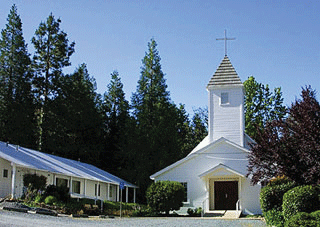Church History

Church History
Historical Highlights:
Back in the 1820's Bible Totin' Jedediah Smith, the Mountain Man, crossed the Sierras, and preached Christianity to the people of the wilderness.
By 1851 Methodist circuit riders were preaching on the Divide.
One tale tells of a circuit riding preacher who was badgered by an inebriated patron of a bar doing double duty as a meeting house. The next week the preacher came into the bar with a revolver in one hand and a Bible in the other. He put both objects on the bar and asked, "Now, are there any questions?"
Conclusive evidence of a Methodist congregation in Georgetown is found in a letter written by a Georgetown miner and printed in "The Pacific". It states: "The Methodists have a small but very neat chapel here, and a small but regular and attentive congregation. Preaching is held once a week and the ministers upon the circuit are held in high esteem by all who know them."
The building was probably a log structure located south of town in Empire Canyon.
Several fires devastated Georgetown, and on August 11, 1852 the church at Georgetown was burned along with most of the town. The town was rebuilt higher upon the Divide with 100 foot wide streets.
The next church was built on the corner of El Dorado (Highway 193) and Church Street.
Other fires burned the town in 1856, 1858, and 1869.
In 1855 a new building was begun, but before construction was completed, the Methodists ran out of money and sold the building to Jack Lewis to be used as a theater. Seven years later when Jack Lewis died, his heirs sold it back to the Methodists to be used as a Union Church. Roman Catholics used the same building.
In 1869 the Trustees declared the building unsafe and tore it down.
By 1873 there was a parsonage; this is evidenced by the writing of author George Amos Miller in his book, Growing Up. The author and his father came to Georgetown and stayed for three years in the Methodist parsonage.
The new and present Methodist Church was planned in February of 1889. It was to be 24 X 84 with a reading room in front for young men. The building went up quickly: stone and brick and lumber were delivered on the 17th of February and by the 28th the frame was finished. On March 3rd the corner stone was laid; at two 'clock on March 7th, a sermon was delivered the text of which was "Christ the Chief Corner Stone". The cost of the church was $1500., and by June of 1889 the church was paid for!
On May 26th, 1892 a bell was placed in the belfry. This little ornament was a benefit to the town, and both the town and the church thrivedand prospered until the beginning of the 20th Century.
Then came the reverses: mines became exhausted; residents abandoned three near-by towns; lumbering began and its heyday was gone. Unemployed and discouraged towns' people moved on to find work. The church barely survived. Rebecca Elliott says she and one other woman were the only ones to come and listen to Jess Rudgin's sermons. Manny Liddicoat tells of his devout and determined grandmother sweeping the church each Sunday and filling it with flowers.
And then the town revived. By 1951 the church proposed two additional rooms to be built on the front of the church for classrooms. Also, planned was a new steeple.
In 1959 two lots at the end of Church Street were purchased, and with the help of three moving trucks and most of the populace of Georgetown, the 72-year old church with its tall steeple and the cross intact, moved slowly and sedately up tree lined Church Street to its present location.
When the building was moved, the old, original cornerstone was found. It contained the names of the pastor and those who had worked on the church and those who had contributed to the building fund.
Melissa Buckner, the first woman pastor (1956-1965) was honored by having the Fellowship Hall named for her. Marion Henniss drew up the plans and presented them to the Board of Trustees in January of 1964. The building was finished on April 27, 1965. The mortgage was burned on December 30, 1973.
In 1989, when the church building was one hundred years old, Frances Richards wrote, "Now in the year of 1989, well traveled and over one hundred years old, she is still serenely beautiful, with an aura of spirituality that even we of short acquaintance recognize and feel at once."
And from the Gazette and Town Crier of 1982: "And so the gabled and towered white Methodist Church remains. Grown beautiful and proud with years, its cross held high in Georgetown's sky, the last of the historic churches of the Divide is still in use. The bell in its tower summons an ever growing congregation to service. The church can dream of the past and look forward with new hope and assurance to the future.

